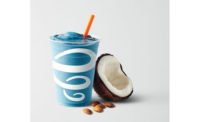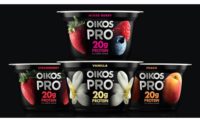2021 Predictions: BEVERAGES
Consumers Turn to Beverages to Boost Mind & Body
The spotlight will be on products that promote health and wellness, escapism and value

Weller says its new Sparkling Immunity is the only sparkling elderberry product to deliver essential vitamins and minerals and provide core, daily immunity support for people on the go.
PHOTO COURTESY OF: MOJIS INC. (WWW.WELLERYOU.COM)

At-Home Escapes: Aqua ViTea expanded its AfterGlow Hard Kombucha line with new flavors.
PHOTO COURTESY OF: AQUA VITEA (WWW.AFTERGLOWKOMBUCHA.COM)


In 2020, the world as we knew it was turned upside down. Coronavirus changed the way consumers shop, socialize, entertain and more which is why it will be the biggest driver of food and beverage trends in 2021.
The spotlight will be on products that promote health and wellness, escapism and value.
Health and wellness will be focused on maintaining a healthy body and mind. In addition to staying physically fit, eating a better diet and taking measures to improve emotional health, feeling safe will be a top priority for consumers.
Consumers will also be more cost-conscious because of economic uncertainty, which will drive demand for value. Although, there will still be space for premium products that provide exciting experiences to fill the void of other forms of entertainment that consumers are missing because of the pandemic like travel and eating at restaurants.
These trends will not be mutually exclusive, and many products in 2021 trends will address multiple consumer needs. Based on these considerations, here are the top trends to watch:
-
Better body – Consumers will aim to improve physical health by paying closer attention to macronutrients, maintaining a healthy weight, and choosing products suggested to boost immunity. Ingredients that promote gut health, improve hydration and have anti-inflammatory properties will be in the spotlight. Superfoods that are naturally rich in immune-boosting ingredients like elderberry, acerola cherry, apple cider vinegar, ginger and turmeric will be popular. Brands will also fortify products with ingredients like zinc, vitamin C, probiotics and prebiotics.
Consumers also will focus on getting in shape to lose extra pounds gained during quarantine and to improve overall health. Launches of sports nutrition products like protein drinks, electrolyte replenishers, performance enhancers, energy boosters and weight loss elixirs will increase. Brands will differentiate products by using clean label, plant-based, and/or diet-friendly ingredients as well as incorporating multiple functional ingredients in a single product to give consumers more bang for their buck. -
Mood Boosters – Stress is at an all-time high for many consumers which can affect more than just your mood. In order to improve overall wellbeing, consumers will put greater emphasis on products that promote relaxation, mental clarity and improve sleep. Ingredients like adaptogens, CBD and l-theanine will be incorporated into products to help consumers unwind.
Consumers will also seek out comfort foods to relieve stress. In order to provide emotional benefits of comfort food without negatively impacting physical health goals, brands will focus on launching permissibly indulgent products made with better-for-you ingredients. This will include reducing sugar or swapping it out for natural low-calorie sweeteners like stevia, monk fruit and allulose; improving nutrient density; and incorporating plant-based, functional and clean label ingredients. Another way to deliver comfort is through use of nostalgic flavors reminiscent of childhood favorites like s’mores or birthday cake flavored products, or seasonal flavors like lemonade in the summer and pumpkin in the fall. -
Culinary tourism – Since consumers are spending less time traveling and going to restaurants, they will seek out products that provide adventurous experiences at home. There will be greater demand for premium bar options like ready-to-drink cocktails and better-for you libations like hard kombucha and enhanced beer, cider and seltzer. Zero-proof spirits that provide a similar experience to drinking alcohol by incorporating flavorful botanicals and relaxing ingredients like adaptogens and CBD will experience growth as well.
Additionally, there will be a resurgence of do-it-yourself (DIY) kits that alleviate boredom and offer experiences akin to foodservice. Consumers will purchase meal kits, many of which will be offered by foodservice brands. Other desirable kits will include DIY alcohol fermentation, mixology, dairy alternative milks, kombucha, and more.
Globally-inspired products and flavors will also be favored in lieu of vacationing abroad. Brands will experiment with Mediterranean flavors like blood orange, orange blossom, bergamot, figs and dates. There will also be continued growth of flavors from Latin America like guava, chamoy, and mango chili lime and flavors from Asia like yuzu, calamansi, tamarind and cardamom. - Safety First — Consumers are making purchase decisions based on what makes them feel safe, which will affect the food and beverage industry several ways. Foodservice brands will need to be transparent about business practices so consumers feel safe eating out. Consumers will be paying attention to product packaging and will be more accepting of single-use and tamper-proof packaging because of concerns about hygiene and contamination. The boom in online shopping will continue until there is a significant drop in illness rates and/or a vaccine becomes widely accessible.
- More for less – Rises in infection rates have consumers stocking up on groceries for weeks to months at a time, but due to economic uncertainty those purchases need to be at a lower price point. There will be an explosion of innovation from private label brands who will launch products in growing categories like dairy alternative milks, immunity beverages and alcohol. Name brands also will offer value to consumers by launching multi-serve products, variety packs with multiple flavors and shelf-stable options.
Looking for a reprint of this article?
From high-res PDFs to custom plaques, order your copy today!







